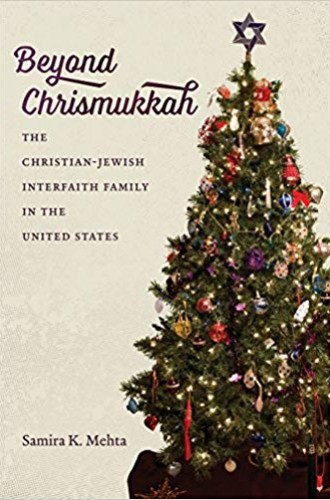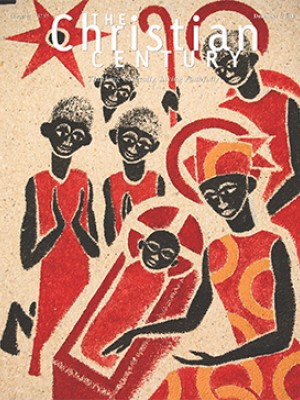How Christian-Jewish intermarriage became normal
Samira Mehta shows how some interfaith families mediate diverse traditions.
Despite the best efforts of religious leaders to discourage and prevent it, interfaith marriage has increased exponentially since the 1970s. What does that mean for clergy and religious communities today and in the future? Is intermarriage creating a new American religion?
With an ethnographer’s tools, religious studies professor Samira K. Mehta examines the data, interviews those who are affected, and comes to the conclusion that the behavior of interfaith families is transforming America’s religious landscape in unexpected ways. Using for its title the portmanteau that joins Christmas and Hanukkah—a neologism which entered popular culture via television in 2003—the book dissects the role popular culture has played in mainstreaming what was, until the 1960s, a relatively rare occurrence. Recent surveys show that some 20 percent of American adults grew up in interfaith homes. “Interfaith family life . . . is a major and formative piece of the American religious landscape,” Mehta writes.
Read our latest issue or browse back issues.
Mehta focuses on Jewish-Christian marriage because she believes it provides the archetype for interfaith marriage in the United States through representations in popular culture and the American imagination. The rise of Jewish-Christian marriage coincides with a shift among adherents of Judaism from a racial and ethnic to a religious self-understanding. Jewish-Christian marriages “provide an important model for how Americans define the ever-shifting terms of ‘religion,’ ‘culture,’ and ‘ethnicity’ in families formed in our increasingly pluralistic society.”
Herself the product of a Unitarian-Hindu marriage, Mehta begins her study with the 1966 pamphlet produced by the General Commission on Chaplains and Armed Forces Personnel responding to what was then generally seen as an unwelcome transformation in the accepted order. Catholic, Jewish, and Protestant clergy—for distinctly different reasons—pronounced interfaith marriage as a threat to the American family as well as to religious institutions. The chaplains focused on discouraging interfaith marriage and, where it happens, encouraged conversion of one spouse so the family could have a unified religious outlook.
Mehta moves quickly from the stern warnings of the chaplains—echoed by other religious leaders at the time—to the embrace of Jewish-Christian marriage in popular culture, particularly in television series, but also in books. Interfaith marriage became so mainstream, it ceased to be mentioned as an issue of concern in the pages of the Christian Century. “Endogamous marriage was simply not a hot-button issue for the Protestant mainline . . . who lost far more people to secularism than to interfaith marriage,” she explains. By the 1980s, talk about preventing intermarriage or encouraging conversion of one spouse largely disappeared, including from the agenda of my own agency, the American Jewish Committee.
Mehta relies heavily on a few informants. She interviewed more than 30 interfaith family members but highlights the experiences of four. As avatars, these families provide insight into many of the challenges facing interfaith families, including having limited or no acceptance from adherents of their formative religious community. Some of them are strident in their belief and demand that their practices be accepted as authentic if not authoritative. They are active, even passionate consumers of religious practices and behaviors but aloof and detached from beliefs. They light Hanukkah menorahs next to their Christmas trees. They attend, and even host, Passover seders while also participating in Easter rituals.
Mehta keeps an appropriate professional distance and is descriptive rather than prescriptive in her approach. But the book has some limitations. Mehta tries to be both popular and academic, which leads her to repeat data more than would be typical in a book for a popular audience. She focuses on the evolving approach of Judaism’s Reform movement to intermarriage, largely ignoring what is happening in the Orthodox and Conservative streams of Judaism. Still, pastors, rabbis, religious educators, and people of faith who read the book will learn about some of the ways intermarried couples and their children mediate the diverse religious traditions of America.
Mehta’s conclusions may bring comfort to some but will certainly not settle the debate within both Jewish and Christian communities about whether interfaith marriage is inherently good or bad. One aspect of that debate—outreach to the intermarried—continues to roil religious circles. Catholics are becoming more comfortable having priests co-officiate at interfaith weddings, and the Conservative movement of Judaism recently discussed, yet again, whether or not their rabbis may perform interfaith weddings. (So far the answer is still no.)
Whether religious intermarriage is good for American religions or what its long-term impact will be, Mehta does not attempt to answer. As to how it affects the children of intermarriage, she suggests that they will be OK. But will they be religious in ways that would be recognizable to their grandparents? Only more time will tell. To those who are looking for ways to halt or at least slow the rate of intermarriage, Mehta would likely say, “That train has left the station.”






